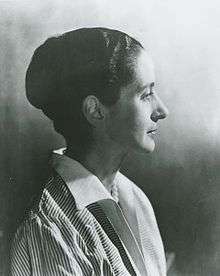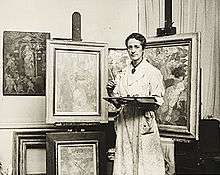Isabel Bishop
| Isabel Bishop | |
|---|---|
 Isabel Bishop, 1959 - Photograph from the Archives of American Art, Smithsonian Institution | |
| Born |
March 3, 1902 Cincinnati, Ohio, |
| Died | February 19, 1988 (aged 85) |
| Nationality | American |
| Education | New York School of Applied Design for Women |
| Known for | Painting, graphic design |

Isabel Bishop (March 3, 1902 – February 19, 1988) was an American painter and graphic artist who depicted urban scenes of Union Square, New York, from the 1930s to the 1970s. She is best known for her depiction of American women and as a leading member of the Fourteenth Street School of artists.
Early life and education
Bishop was born in Cincinnati, Ohio. Her parents were descended from old, wealthy and highly educated East Coast mercantile families.[1] Her father was a scholar of Greek and Latin, and her mother was an aspiring writer as well as an early activist for women's suffrage. After the family relocated to Detroit, Bishop began her art education at the age of 12 in a Saturday morning life drawing class at the John Wicker Art School in Detroit.[2] Upon graduating from high school, Bishop moved to New York to pursue a career as a graphic artist.[2]
At the age of 16 she moved to New York City to study illustration at the New York School of Applied Design for Women. After two years there she shifted from illustration to painting, and attended the Art Students League for four years until 1924. It was there that she studied with Guy Pène du Bois and with Kenneth Hayes Miller, from whom she adapted a technique which owed much to baroque Flemish painting.[2] In addition, she learned from other early modernists including Max Weber and Robert Henri. During the early 1920s she also studied and painted in Woodstock, New York.
Career
Through the 1920s and 1930s she developed a realist style of painting, primarily depicting women in their daily routine on the streets of Manhattan. Her work was greatly influenced by Peter Paul Rubens and other Dutch and Flemish painters that she had discovered during trips to Europe. In 1932, Bishop began showing her work frequently at the newly opened Midtown Galleries, where her work would be represented throughout her career.[3]
In 1934, Bishop married Dr. Harold G. Wolff, a neurologist, and moved to Riverdale New York. However, she continued to work in a loft studio near Union Square at 9 West Fourteenth St, which she continued to use until 1984.[4] She became interested in the interaction of form and ground and the mobility of everyday life, what she called "unfixity", life and movement captured on canvas.[4] Her style is noted for its sensitive modeling of form and "a submarine pearliness and density of atmosphere".[5] During this time, Bishop began working in various printing techniques, most notably aquatint.
She returned to the Art Students League as an instructor from 1936 to 1937. In 1940, Bishop was elected into the National Academy of Design as an associate member, and became a full member in 1941.
In 1938, she painted a post office mural, Great Men Came from the Hills, in New Lexington, Ohio, through the Section of Painting and Sculpture.[6]
Bishop's mature works mainly depict the inhabitants of New York's Union Square area. Her portraits are often studies of individual heads (see Laughing Head, 1938, Butler Institute of American Art); the emphasis securely on the subject's expression – or of solitary nudes. Bishop was also a pioneer in multiple-figure compositions, often containing two females engaged in various workday interactions. In the post-war years, Bishop's interest turned to more abstracted scenes of New Yorkers walking and traveling, in the streets or on the subways. Her signature changed many times over her career, ranging from the use of various pseudonyms to initials; some early pieces are signed I.B, or I. Bishop in both block and script. Her work remains significant as an example of the thematic concerns of the Fourteenth St. School, as well as her contribution to feminism and the "new woman" emerging in urban landscapes.
In the mid-1940s, E. P. Dutton commissioned Bishop to illustrate a new edition of Jane Austen's novel Pride and Prejudice. Bishop produced 31 pen-and-ink drawings (the originals are now at the Pierpoint Morgan Library).
Notable works
"Virgil and Dante in Union Square" 1932
This piece hung in Bishop's Riverdale home for more than seven years, and set the leitmotif of her career.[7] As a child, Bishop became familiar with the story of Virgil and Dante through her mother, who was translating the text from Italian. Dante's journey through heaven and hell represented the extraordinary depth to life and its many experiences. The two figures standing in front of Union Square adds a narrative element to the bustling scene of life in a city of millions, and sets the scene for her various paintings and prints of urban life.
"Two Girls" 1935 One of Bishop's most well-known works, the painting took more than a year to complete and was shown at the Midtown Galleries.[8] For the piece, Bishop had two acquaintances from the Union Square area pose, wanting to capture the interaction of the two figures. The piece was painted with oil and tempera.
"Encounter" 1940 In Encounter, Bishop continues with her multiple-figure compositions capturing a scene of interaction between a man and a woman on a city street. Her depiction of the woman as forthright and confident, approaching the man and backing him against a wall, exemplifies Bishop's understanding of shifting gender roles at the time.
Students Walking 1967 One of Bishop's later and most abstracted works. In this piece, Bishop's modeled forms seem to dissolve into the background and even mix with each other. Bishop seems to highlight the transitory nature of life and how lives intermingle in vast urban settings.
Notes
- The Isabel Bishop Papers, 1914-1983 have been digitized and posted online by the Archives of American Art, Smithsonian Institution. These primary source historical documents include biographical documents, correspondence, writings and notes, exhibition catalogs, photographs of Bishop with her husband and in her studio, original artwork including 8 sketchbooks, loose sketches, prints, and watercolor figure studies.
- The American indie rock band Unrest released an EP named the Isabel Bishop E.P. in 1993, with Bishop's picture on the cover.
- Bishop is in the Permanent collection of Berkshire Museum in Pittsfield, Massachusetts and the Boca Raton Museum of Art in Boca Raton, Florida.
- One of Bishop's illustrations for Pride and Prejudice—of Elizabeth Bennet reading a letter from Jane—will be prominently featured on the £10 note honoring Jane Austen. The note will be in circulation in 2016.[9]
References
| Wikiquote has quotations related to: Isabel Bishop |
| Wikimedia Commons has media related to Isabel Bishop. |
Footnotes
- ↑ Todd, Eileen. The "New Woman": Painting and Gender Politics on Fourteenth Street. p. 56
- 1 2 3 Todd, Eileen. The "New Woman": Painting and Gender Politics on Fourteenth Street. p. 57
- ↑ Todd, Eileen. The "New Woman": Painting and Gender Politics on Fourteenth Street. p. 58
- 1 2 Lunde, Karl. Isabel Bishop. p. 23
- ↑ Lunde, Karl. p. 27
- ↑ "Post Office Mural – New Lexington OH". Living New Deal. Retrieved 2016-03-21.
- ↑ Lunde, Karl. p. 23
- ↑ Lunde, Karl. p. 35
- ↑ Jane Austen to feature on Bank of England banknotes, Banknote Character Announcements, Bank of England, July 2013.
Sources
- Helen Yglesias, Isabel Bishop, New York, Rizzoli, 1988
- Thompson, James. Isabel Bishop 1902. Retrieved Aug. 19, 2005.
- Isabel Bishop. Retrieved Aug. 19, 2005.